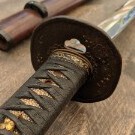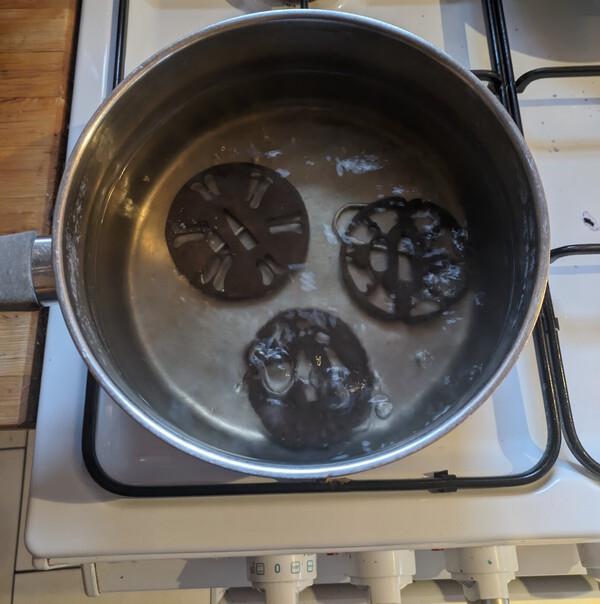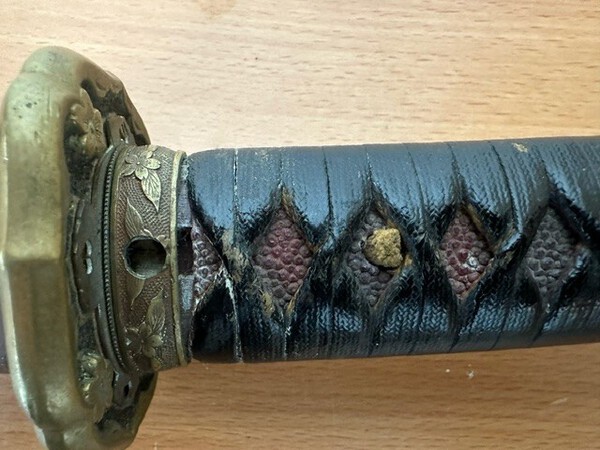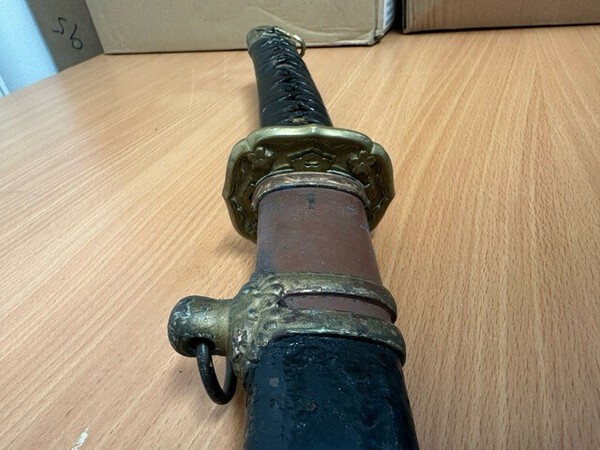-
Posts
228 -
Joined
-
Last visited
Everything posted by George KN
-

Thoughts on my bargin bin Type 98
George KN replied to sleepy_hue's topic in Military Swords of Japan
Looks to me like a nice sword, and welcome to the forum! There's a bit more details on the late war variations here: https://www.Japanese...dex.com/military.htm I'm not really qualified to say any more (although other people here definitely are), but I'd definitely like more pics, since I've never seen one of these in person yet My only initial thoughts is the habaki and other fittings look like they've been cleaned possibly a bit too well. Also, Is there no wooden lining inside the scabbard/saya? (A pic of the inside would be good) Other people can hopefully help with this, as you definitely don't want to damage the fittings, but I have a feeling late war swords like this one have not just one mekugi peg, but two - I think I can see a wooden one further down the handle? -

Trying to get info on an estate sale find (gunto?)
George KN replied to mackiejamie's topic in Nihonto
Hey Jamie - the first sword I bought was a complete fake too, and I've also ended up buying a few fake tsuba after that as well! Each fake or bad situation I've ran headlong into has taught me so much because I've been honest enough (or stupid enough) to post about it on this forum and learnt from all the feedback I've got. Its definitely not always easy and yes, Jean is right, I don't like paying fakers either, but at this stage I think it's just the price of tuition on the subject -

On a scale of 0-10, how fake is this sword?
George KN replied to George KN's topic in Military Swords of Japan
Honestly though, thank you all for your help with this - the only reason I was even able to identify this sword as one to bid on was from the things I've learnt from this forum - and I've learnt so much more just from this thread and reading up on all the loose ends. 😄 -

On a scale of 0-10, how fake is this sword?
George KN replied to George KN's topic in Military Swords of Japan
Ah sorry, I seem to have muddied the waters a bit using the word slave - I meant unpaid labour by people that couldn't leave of their own free will 🙃 (although I am glad there is still pride in the work, this does help explain the quality of the swords made) The Emura is already teaching me much though - like I did not realize the mune could be a different, wider shape near the kissaki, as it isn't like that on my other Nihonto: Still much to study - and Uchiko is already enroute from https://www.bushidoj...ds.com/supplies.html so I hope to be able to remove at least some of the stains on the sword. -

On a scale of 0-10, how fake is this sword?
George KN replied to George KN's topic in Military Swords of Japan
So 1938 to 1945, likely 1943/44 - I can work with that thank you! I found other examples of the two character signature too, not even from that long ago: https://www.militaria.co.za/nmb/topic/31267-emura/ The fact that this blade could have been partly or wholly made from slave labour is quite sobering - I didn't know that was a possibility with Nihonto, since I assumed it was a protected and revered profession... Interestingly the blade does feel much more dangerous than my other two Nihonto. It's certainly a lot sharper. And I'm not sure how, but the entire edge seems to be rather jagged. It's strange because I can't see any other evidence of cutting or heavy rust, but there are also two nicks to the back of the blade: After further investigation, I'm also not happy putting it back into its original koshirae - there are quite a lot of scratches that I think could be from the saya somehow, and worse, the saya is *very* mouldy: I do think your recommendation Klaus and Brian of a Shirasaya is the way to go - for now, it can live safely in this box (I've wrapped the kissaki and will store it only horizontally) - at least between periods of me studying/admiring it: Does the mould mean the saya and tsuka are lost causes? If so, there's a chance it might actually have been the last time it was drawn from and fitted with its original koshirae today 🥲 -

On a scale of 0-10, how fake is this sword?
George KN replied to George KN's topic in Military Swords of Japan
Not even the tsuba remains unaffected - on one side some dirty grey/black coating, and on the other what looks like white trim: Only the seppa remain (mostly) unaffected - all with matching assembly numbers Edit: I just noticed the tsuka under the loose fuchi also has the same 11 assembly number - so I'm now pretty certain this is all one coherent koshirae (albeit in pretty bad condition) -

On a scale of 0-10, how fake is this sword?
George KN replied to George KN's topic in Military Swords of Japan
The saya is a right mess too - it looks like it it has been painted brown, red, blue, and black - with the fittings also having most recently been painted silver? Even for a post-war job it feels like an unusual array of colours -

On a scale of 0-10, how fake is this sword?
George KN replied to George KN's topic in Military Swords of Japan
Thanks guys! I'm over the moon at finally having a real piece of wartime history in the house, let alone another Nihonto If there is no date mentioned, is it possible to work out what year it was made based on just the signature? I've noticed Emura has quite a few different signatures. And as for the koshirae... Well, it looks like almost every owner its ever had has painted it a different colour! Multicoloured tsuka aren't common are they? (purple/red/purple/red) Not sure what to do about the fuchi just falling off... -

On a scale of 0-10, how fake is this sword?
George KN replied to George KN's topic in Military Swords of Japan
Whhhoooop! When I saw the signature I thought for sure it would be Showato/factory made, just because there were only two characters... What does the mei literally translate as? Is it just "Emura" and nothing else? Most importantly, does this mean it's a 100% Nihonto, and would be able to be registered, polished, shinsha etc in Japan if ever needed? -

On a scale of 0-10, how fake is this sword?
George KN replied to George KN's topic in Military Swords of Japan
The sword has finally arrived today! Better late than never. Also, it's mekugi was missing, which is the second time this has happened from an auction... It is strangely a very colourful sword - I'm still at work, but will try to post more pics when I can. -
Point taken, I shall stop trying to whittle them with a knife 😅 Also, as to boiling the tsuba, these were my primary sources of information (just so people don't think I'm completely insane): http://www.japaneses...m/tsuba/tsubacln.htm
-
You are also definitely right about material being permanently removed by the rust - I had thought by cleaning I would be able to restore the flat and original surface of the tsuba, but sadly this just doesn't seem possible as the rust has in parts eaten several layers down into the iron. As to the Tekkotsu, even after learning what to look for it is actually really hard to distinguish between small nubs of rust and and genuine bones... I think my tsuba may have been rusting for quite some time, as on places I would remove the surface rust, and below that would look like patina - only for it to fall off at a later stage to reveal the smoother surface underneath. And FYI If there ever is a next time I think I would skip the WD40 and just go straight to boiling (unless there is gold/silver nunome obviously) and bone picks. They are definitely hard and expensive lessons to learn... I will say thought that's quite an impressive array of bone picks you have there, they do take a while to carve!
-
Thanks Jean - and to clarify beyond doubt, I am not trying to promote my methods - I have done considerable harm not once but twice to the tsuba. Don't do what I've done... I am a novice collector, and clearly a very novice restorationist 😅 The problem is, there are very few resources online to do with tsuba, and even less about rust removal. What scraps I ran into online seem very divided. Bone does work - but I had real problems getting into the tight corners of the chestnut tsuba. It also couldn't seem to touch patches of the heavy rust on two of the other ones. In fact, if was because I was having to apply pressure when using bone that I ended up scratching the schakudo. Please don't mistake me, this is not trying to be an instruction guide! I've simply tried to solve the issue of the heavy corrosion by trying one method after the other, trying what I assumed would be the least risky one first and moving on to riskier methods after months of the bone picks. I just felt that instead of hide my failures, I should the post them - there just aren't enough examples online of *why* things are a bad idea, and why some things are better than others.
-
Wow Paul, that looks great! I've never been to the Birmingham arms fair (assuming it was from here since it was today), I always assumed it would be really expensive - but I think I'll show up to the next one... Congrats again
-
After learning that harsh lesson, I have since used the pens much more sparingly on only very limited areas, to achieve what I consider to be a better level of cleanliness/rust-free-ness on the other two tsuba: There are one or two small spots of rust I may do some very light cleaning again on - but I am now incredibly cautious about overcleaning. Better under cleaned than over. So to update my learnings list: 1. Bone can scratch Shakudo 2. Bone will eventually scratch/wear through patina 3. Cleaning will reveal existing damage or flaws 4. Flaked rust or metal from the cleaning can get under the tsuba if you are cleaning on a table/hard surface, and as you continue to clean and apply pressure to the tsuba, scratch the Shakudo without you noticing 5. Shakudo will after many months eventually return back to black (or has at least in my case) 6. Boiling iron tsuba did not seem to visibily damage my tsuba, even with Shakudo and copper on 7. Fiberglass pens are harder than bone, but EASILY scratch patina completely off. I will now only use them in extreme cases of heavy rust, and only in targeted areas 8. ALWAYS work in a brightly lit room 9. Sometimes decoration is not being hidden by rust, it can actually be completely warn away (the same with mei) 10. Uneven bumps on otherwise smooth curves (especially around the rim) may not be due to rust, but due to the tsuba's bones
-
To finally try and get through the worst rust, I then went further to the dark side, and bought myself some fiberglass pens. These cut through the rust like butter - and had very fine nibs, so were perfect for getting into the crevices I wasn't able to with the bone. However, this is where I cocked up quite badly. As I got more comfortable with using the pens, I got more complacent, and was cleaning at night instead of in a well lit room. I didn't realise until the next day, but I had badly scratched the patina of the tsuba I was working on: The reason for the scratches mostly being on the leaves of the tsuba is I thought the carved lines were hiding under rust (since they were there on one side) - however it turned out that they weren't, they had simply completely worn away, and as you can see I ended up hitting bare metal. Similarly, around the edge of the tsuba were quite a few uneven lumps which I had foolishly assumed were rust. However, these too hit bare metal - I believe these uneven parts are what would be called the tsuba's "bones", which I only learnt about after the fact... I am very upset I ended up scratching it so badly!! Honestly you can't see the damage in low light levels, and it's really frustrating to think of how many decades, even centuries of patina I have simply destroyed in under half an hour. Fiberglass pens are dangerous. To add salt to the wound, the shakudo had actually self-healed really well over the months, so my previous big mistake had already been almost erased. I heavily suspect the new scratches in the iron will take much longer than that to repatinate though...
-
It's been about five months since I last posted about my tsuba cleaning journey, and I've had some success, but also made more mistakes. Rather than hide them, I figure that I should at least share things so it can help prevent a repeat of my worst errors in the future. Since January I continued applying WD40, waiting for it to dry, and then cleaning with bone in numerous repeated cycles. This worked well for parts of the tsuba, but there were patches where the rust was just too thick, forming almost a second skin, and the bone was unable to get through this. There were also pits and awkward corners that were too small for the bone pieces I was using to get to. I was nervous to try this, but to try and loosen the rust across all the tsuba at once, I boiling them in water for 20 minutes each, starting at first with the cast tsuba to see how it would react: Surprisingly, this did actually work quite well, and I would consider it a success - a lot of the hidden rust turned much more orange, and it was possible to remove a lot more. It even worked with the tsuba that had shakudo and copper, with no ill effects to the black patina or copper colour. For the record I was using my tap water, which is straight from our well, so I can't rule out chlorinated water causing issues, but it worked for me this time. This led to another round or so of WD40/dry/bone cleaning, but I still couldn't get through the toughest rust. (more to follow)
-

On a scale of 0-10, how fake is this sword?
George KN replied to George KN's topic in Military Swords of Japan
Good news, the auction have shipped the sword today via UPS! I'm hoping it will be with me either tomorrow or Saturday. It was a real concern of mine they would either totally refuse to ship it, or couldn't find a carrier, especially since Royal Mail will no longer take them. In the meantime I have literally spent all week (between bouts of actually doing my job as a programmer) reading through the historic threads - so far made it through 48 of the 131 pages on this subsection alone! The wealth of knowledge here is downright incredible. Especially since learning Showato are mostly illegal in Japan (and regularly destroyed 😭) I'm actually quite keen to acquire one now. Regardless I just want to get the darned thing in my hands!! -
It's a little hard to tell from the current images, but is there a line on the inside of the tsuba, or around the edge? If so, it would suggest it has been cast... The colour/bare metal look is another concern. Is it magnetic? (looks almost like aluminium). For what it's worth, I do like the design
-

On a scale of 0-10, how fake is this sword?
George KN replied to George KN's topic in Military Swords of Japan
Oh wow, wasn't expecting so many responses, thanks all! I'm very much looking forward to getting it in hand, but I'm having to rely on the auctions postage and packing service, so I don't think I'll get it for at least a week. When I do, I'll definitely take close up detailed pictures of all components - especially the nakago! Also: @GeorgeLuucas @Bruce Pennington @PNSSHOGUN @GetFuzzy2 @robinalexander - thanks for the comments about it being worth a gamble - I've definitely been burned by fakes before, but it's nice to know I've not gone completely off the rails here! ~~~ @paul griff - I appreciate the detailed feedback, and yes, I can definitely see some of the things you mention. Could part of the fittings have been changed during the course of the war? I can definitely see why someone would paint part of it black as a field modification. Although from the way it's applied it almost looks like they've used tar 😅 With regards to the solid tsuba - I do wonder whether the seppa have simply been turned around the wrong way which gives the impression there is no hole for a retention button. I guess we'll only know 100% once I take it all apart... ~~~ @lonely panet - money pit of junk? I know the paint and fittings aren't brilliant, but I'm not aiming for that - if even any part of it is genuinely from WW2, surely it's worth preserving in its own right? I feel like what I'm learning just in this thread has already been worth the fee I paid 🙂 ~~~ @Brian you've hit the nail on the head here - I would love all the correct fittings, but it's the blade that holds the vast majority of the historic and artistic value to me. Any sword I would see normally in this price bracket on public auctions are usually absolute trainwrecks of rust or sandpaper scratches. It would actually look really good in a shirasaya too... -

On a scale of 0-10, how fake is this sword?
George KN replied to George KN's topic in Military Swords of Japan
Thanks Paul and Brian - I thought this sword might be a contentious one from the moment I saw it 😂 It is definitely rough around the edges - to my untrained eye I have already noticed the button/clasp to free the saya seems to be missing, and someone seems to have swapped the order of the seppa. I still question the aluminum look of the fittings on the saya too - is there anything else in particular that concerns you @paul griff? Can't wait for this to get to me and actually open the tsuka to see what we have - so long as the blade itself is genuine and in one piece, I'm actually not too concerned about it being a Frankenstein 🙂 (if it even is) -
Absolutely amazing, this would my a dream blade! Matching assembly numbers so you know it hasn't been tampered with, Mon so you know it was used by someone important, all the history and context of being a historic samurai blade, whilst also having been fitted for war once again only a few generations ago. Not to mention it's also got quite an active hamon, which I do like, and you bought it at a great price - definitely a great sword to study and treasure
-

On a scale of 0-10, how fake is this sword?
George KN replied to George KN's topic in Military Swords of Japan
Thanks Bruce and Rob for your thoughts - much appreciated! Good news everybody, they sent more pictures. Bad news though, they sent them 30 minutes before the auction began, so I didn't have enough time to ask anyone their opinion again 😂 The thing is, for better or worse I have actually bought the darned thing, for just under £300 (which is concerning, since I've seen fakes sell for more than that) It was also only described as a "Japanese Naval Sword" - but as I understand this is likely incorrect? The paint job is still a bit of a concern, but what do you all think now? Have I actually just bought my first WW2 sword, or failed badly? -

On a scale of 0-10, how fake is this sword?
George KN replied to George KN's topic in Military Swords of Japan
Thank you for the thoughts Sam and Brian, much appreciated! And Lee, I've definitely requested more pictures Although it is hard to tell, it looks like the saya fittings have worn down to a silver colour - perhaps aluminium? Or conversely, they were painted silver and are now getting worn back to brass. I've not seen that before either... -
Combine bad pictures from the seller and the huge variety of colours the WW2 Koshirae can come in, and I'm left a bit stumped as to whether this sword is fake or not: I've had a search around the forums and I can't find any similar brown and black combo's. Has anyone seen this before? I'm also a bit worried the brasswork looks a bit odd too. So on a scale of 0-10 (10 being 100% fake), any thoughts on how I should rank this?
























































